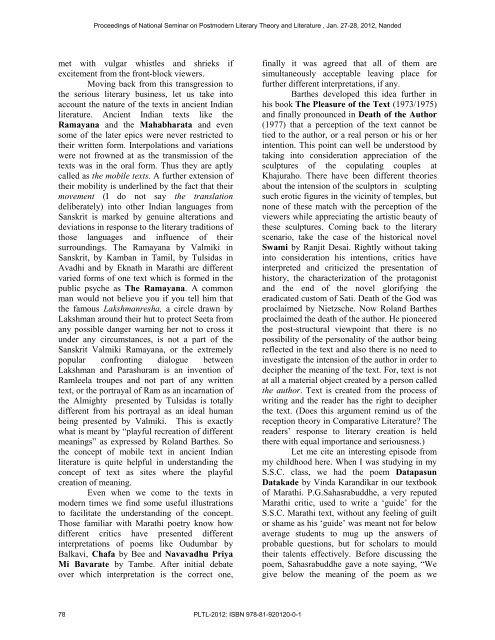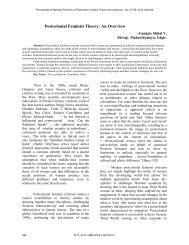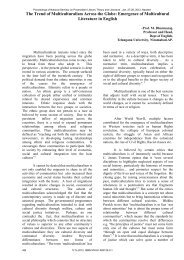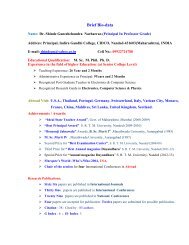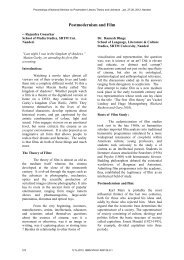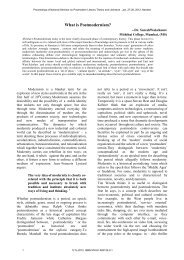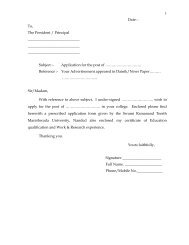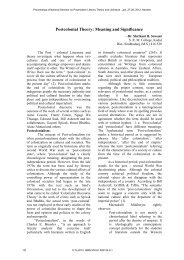Post-Structuralism: An Indian Preview - Igcollege.org
Post-Structuralism: An Indian Preview - Igcollege.org
Post-Structuralism: An Indian Preview - Igcollege.org
You also want an ePaper? Increase the reach of your titles
YUMPU automatically turns print PDFs into web optimized ePapers that Google loves.
Proceedings of National Seminar on <strong>Post</strong>modern Literary Theory and Literature , Jan. 27-28, 2012, Nanded<br />
met with vulgar whistles and shrieks if<br />
excitement from the front-block viewers.<br />
Moving back from this transgression to<br />
the serious literary business, let us take into<br />
account the nature of the texts in ancient <strong>Indian</strong><br />
literature. <strong>An</strong>cient <strong>Indian</strong> texts like the<br />
Ramayana and the Mahabharata and even<br />
some of the later epics were never restricted to<br />
their written form. Interpolations and variations<br />
were not frowned at as the transmission of the<br />
texts was in the oral form. Thus they are aptly<br />
called as the mobile texts. A further extension of<br />
their mobility is underlined by the fact that their<br />
movement (I do not say the translation<br />
deliberately) into other <strong>Indian</strong> languages from<br />
Sanskrit is marked by genuine alterations and<br />
deviations in response to the literary traditions of<br />
those languages and influence of their<br />
surroundings. The Ramayana by Valmiki in<br />
Sanskrit, by Kamban in Tamil, by Tulsidas in<br />
Avadhi and by Eknath in Marathi are different<br />
varied forms of one text which is formed in the<br />
public psyche as The Ramayana. A common<br />
man would not believe you if you tell him that<br />
the famous Lakshmanresha, a circle drawn by<br />
Lakshman around their hut to protect Seeta from<br />
any possible danger warning her not to cross it<br />
under any circumstances, is not a part of the<br />
Sanskrit Valmiki Ramayana, or the extremely<br />
popular confronting dialogue between<br />
Lakshman and Parashuram is an invention of<br />
Ramleela troupes and not part of any written<br />
text, or the portrayal of Ram as an incarnation of<br />
the Almighty presented by Tulsidas is totally<br />
different from his portrayal as an ideal human<br />
being presented by Valmiki. This is exactly<br />
what is meant by “playful recreation of different<br />
meanings” as expressed by Roland Barthes. So<br />
the concept of mobile text in ancient <strong>Indian</strong><br />
literature is quite helpful in understanding the<br />
concept of text as sites where the playful<br />
creation of meaning.<br />
Even when we come to the texts in<br />
modern times we find some useful illustrations<br />
to facilitate the understanding of the concept.<br />
Those familiar with Marathi poetry know how<br />
different critics have presented different<br />
interpretations of poems like Oudumbar by<br />
Balkavi, Chafa by Bee and Navavadhu Priya<br />
Mi Bavarate by Tambe. After initial debate<br />
over which interpretation is the correct one,<br />
finally it was agreed that all of them are<br />
simultaneously acceptable leaving place for<br />
further different interpretations, if any.<br />
Barthes developed this idea further in<br />
his book The Pleasure of the Text (1973/1975)<br />
and finally pronounced in Death of the Author<br />
(1977) that a perception of the text cannot be<br />
tied to the author, or a real person or his or her<br />
intention. This point can well be understood by<br />
taking into consideration appreciation of the<br />
sculptures of the copulating couples at<br />
Khajuraho. There have been different theories<br />
about the intension of the sculptors in sculpting<br />
such erotic figures in the vicinity of temples, but<br />
none of these match with the perception of the<br />
viewers while appreciating the artistic beauty of<br />
these sculptures. Coming back to the literary<br />
scenario, take the case of the historical novel<br />
Swami by Ranjit Desai. Rightly without taking<br />
into consideration his intentions, critics have<br />
interpreted and criticized the presentation of<br />
history, the characterization of the protagonist<br />
and the end of the novel glorifying the<br />
eradicated custom of Sati. Death of the God was<br />
proclaimed by Nietzsche. Now Roland Barthes<br />
proclaimed the death of the author. He pioneered<br />
the post-structural viewpoint that there is no<br />
possibility of the personality of the author being<br />
reflected in the text and also there is no need to<br />
investigate the intension of the author in order to<br />
decipher the meaning of the text. For, text is not<br />
at all a material object created by a person called<br />
the author. Text is created from the process of<br />
writing and the reader has the right to decipher<br />
the text. (Does this argument remind us of the<br />
reception theory in Comparative Literature? The<br />
readers’ response to literary creation is held<br />
there with equal importance and seriousness.)<br />
Let me cite an interesting episode from<br />
my childhood here. When I was studying in my<br />
S.S.C. class, we had the poem Datapasun<br />
Datakade by Vinda Karandikar in our textbook<br />
of Marathi. P.G.Sahasrabuddhe, a very reputed<br />
Marathi critic, used to write a ‘guide’ for the<br />
S.S.C. Marathi text, without any feeling of guilt<br />
or shame as his ‘guide’ was meant not for below<br />
average students to mug up the answers of<br />
probable questions, but for scholars to mould<br />
their talents effectively. Before discussing the<br />
poem, Sahasrabuddhe gave a note saying, “We<br />
give below the meaning of the poem as we<br />
78 PLTL-2012: ISBN 978-81-920120-0-1


